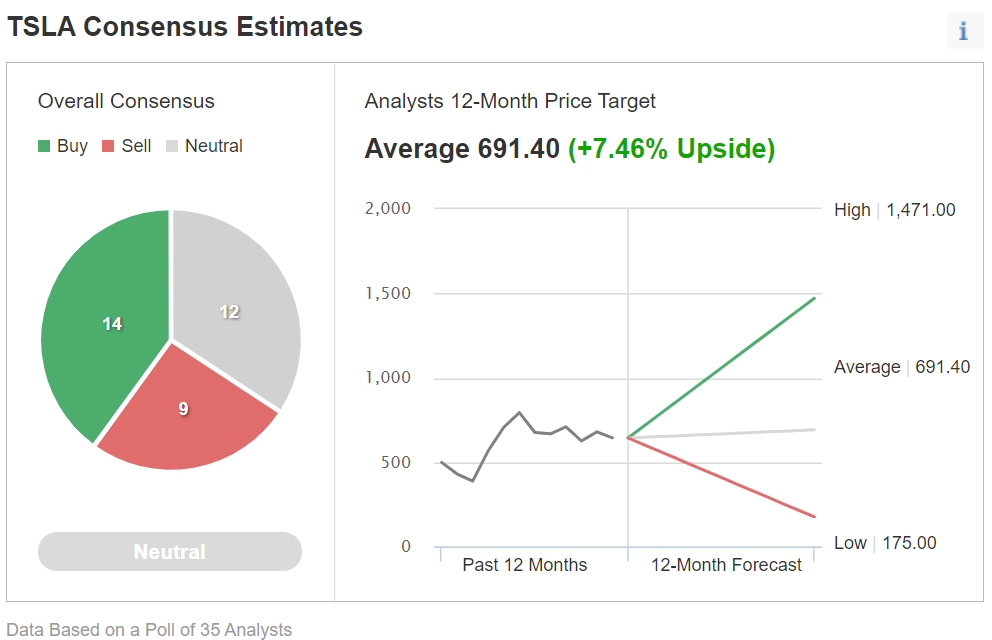- Reports Q2 2021 results on Monday, July 26, after the market closes
- Revenue Expectation: $11.53 billion
- EPS Expectation: $0.936
Despite past turbulence, Tesla (NASDAQ:TSLA) has been a great growth story for investors who remained faithful to the electric carmaker and its stock. Until January of this year, shares of the Palo Alto, California-based EV manufacturer had surged more than 11-fold since the March 2020 low.

After this meteoric move, the trajectory for Tesla shares, and investors who own them, has become uncertain amid growing competitive threats from traditional automakers, signs of a potential sales slowdown in China, and an ongoing semiconductor shortage.
After hitting a record high of $900.40 on Jan. 4 of this year, Tesla stock has fallen 28%, massively underperforming the broader market which continued to rise during this period. The stock closed on Friday at $643.38.
When Tesla releases its latest earnings report later today, founder and CEO Elon Musk will likely face questions on whether the EV automaker's best days are still ahead from a growth perspective.
The company’s latest production and delivery numbers, released at the beginning of July were encouraging. TSLA told investors it had delivered 201,250 cars worldwide during the second quarter, a record number for the company despite chip shortages and concerns about the sales fall-off in its China market. However, record deliveries notwithstanding, CNBC noted, "deliveries fell slightly short of expectations."
The bulk of sales during the period were for the Model 3 sedan and the Model Y crossover, produced in the company's Shanghai and Fremont, California factories. Those countries are also Tesla’s biggest markets. This strong delivery performance is an indication that Musk is likely to report another strong quarter.
Analysts’ consensus estimates on today's release also support that view. Tesla profit per share is likely to double from the same period a year ago to $0.9364, while sales will jump 90% to $11.53 billion when compared with the same period last year.
Competition Heating Up
Still, as noted earlier, Tesla’s long-term prospects are becoming less attractive. It's facing threats from automotive sector giants such as General Motors (NYSE:GM), Ford (NYSE:F) and Volkswagen (OTC:VWAGY), each of which is launching its own electric-vehicle lineup. In China, Tesla’s lead over other, regional startups has already started to shrink.
Despite Wall Street’s bullish consensus estimates on Q2 earnings, analysts remain highly divided on Tesla’s stock’s direction.
Just before the earnings report, Goldman Sachs reiterated its buy call for Tesla, saying it sees strong revenue and margin growth. In a note the investment bank said:
“We are Buy-rated on TSLA shares as we expect higher volumes and the company’s leadership position in the rapidly growing EV market to lead to strong revenue and margin growth.”
Barclays’ Brian Johnson, while raising his second-quarter earnings estimate for Tesla to $1.08 per share from $0.92 per share, said its stock is still not a buy. Though maintaining a 12-month price target of $230 on the stock, Johnson also said:
“While we acknowledge the profit improvement from pricing moves in [the second quarter], and potential near-term upside to the shares, we believe some of these will dissipate over time and remain stubbornly underweight on valuation.”
On a longer timeframe, analyst outlook on the stock is also mixed.

Chart: Investing.com
Based on an Investing.com poll of 35 analysts, respondents provided a neutral view of the shares, with the majority seeing a 7% upside target over the next 12 months.
Bottom Line
The short-term outlook for Tesla has brightened after the company produced more cars in Q2 than expected. That shows it’s been succeeding in overcoming supply-chain issues which are hurting other traditional automakers.
But that impressive performance may not be enough to push the stock much higher from current levels as concerns about accelerating competition heat up.
